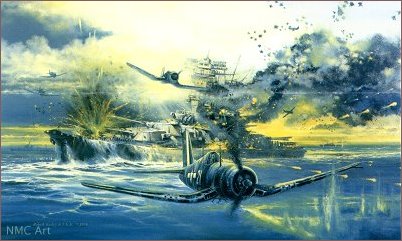
|
Imperial Sacrifice,
by Robert Bailey
|
|
|
In the closing months of the pacific war, Japan was becoming more desperate in the defense of her homeland. The armed forces of Japan had developed more fanatical strategies to thwart the approaching U.S. war machine. The Imperial Japanese Navy was not immune from this, even though the diminished fleet was but a remnant of its former self. Thus, in April of 1945, the fate of the Yamato task group was sealed in a sacrificial plan to reinforce the defenders of Okinawa. With only enough fuel to make the voyage from the Inner Sea of Japan to the island, under assault from the combined American and Allied Forces, the world's largest battleship, together with the light cruiser Yahagi and eight escort destroyers, sailed into the South China Sea. They were tracked by U.S. submarines through the Bungo Straits, their position being relayed to U.S. Task Force 58. There would be no air cover for the Japanese Navy. At approximately half past noon on April 7, 1945, more than 380 U.S. planes from Task Group 58 attacked the Yamato Task Group in three separate air waves. In the ensuing battle that lasted a little more than three hours, the Imperial Japanese Navy ceased to exist. Sunk was the battleship Yamato, the light cruiser Yahagi, and four of the eight escort destroyers. The remaining destroyers limped home to Kure Harbor with what survivors they could find from the sunken ships. The sacrifice for the Japanese was staggering. In addition to the Japanese Navy's loss of pride, 4,250 officers and sailors perished. The loss to American forces were 10 planes and 12 aircrew. Admiral Isoroku Yamamato, the architect who had planned the attack on Pearl Harbor, had predicted this outcome at the beginning of hostilities more than three and a half years prior to this tragic battle. The giant did indeed awaken and returned with a terrible resolve. It would culminate four months later not far from where the keel for the Yamato was laid: Hiroshima and Nagasaki. |
|
 |
|
|
The Signatures: Hal Jackson joined one of the most successful of all U.S. Navy Fighting Squadrons in W.W.II, on January 1, 1943: VP17. He served with it on two tours of duty until it was decommissioned in April 1944. VF-17 became known as the 'Skull and Crossbones' squadron after having adopted the old pirates' ensign of the Jolly Roger as their insignia. During April 1945, Hal Jackson was with VBF-10 aboard the carrier Intrepid, when he was involved in the Yamato strike. He is credited with shooting down I Japanese Betty bomber and 3 Zekes, besides dropping a bomb on the battleship Yamato. Lt. Jackson was known as the 'Nightwatchman of the Wardroom,' owing to his completely bohemian existence amid the otherwise regimented life aboard ship. Never on the flight deck except to take off, the only way he knew whether it was night or day was by activity in the wardroom. His decorations include Z Distinguished Flying Crosses; 8 Air Medals, Silver Star (for role in helping sink the Yamato); World War II Victory Medal; Asiatic-Pacific Campaign Medal with 4 stars; American Campaign Medal; Navy Unit Commendation. He currently lives in Denton, Texas, with his wife Barbara. He practices criminal law. L/E of 500 (23" x 32.5"") Signed and numbered by the artist and Lt Hal Jackson: L.E.P. #163/500 |
|